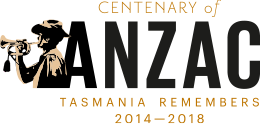Did you know?
Australia’s military history is vast and at time, complex. We have collated some fun and quick did you know facts to help. More facts are continuously being added. Any contribution you might want to add to this section is encouraged. These can be sent to centenaryofanzac@dpac.tas.gov.au.
The ideal solider
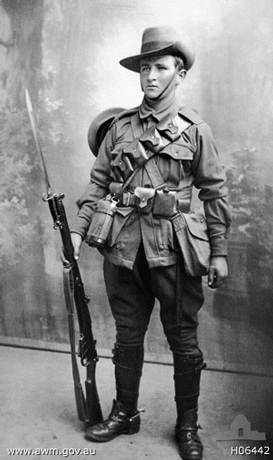 The physical characteristics of the ideal soldier during World War I were:
The physical characteristics of the ideal soldier during World War I were:
Aged between 18 and 35 years old
168 cm in height (5 foot, 6 inches)
Chest measurement of 86cm (34 inches)
Later these requirements were relaxed due to the demand on soldiers needed.
For enlistment in the Light Horse Regiment conditions applied for both rider and horse:
The soldier must be able to ride bare-back and jump over a fence. The horse must be solid brown or grey in colour and be at least 14 ½ hands high.
Purple Heart
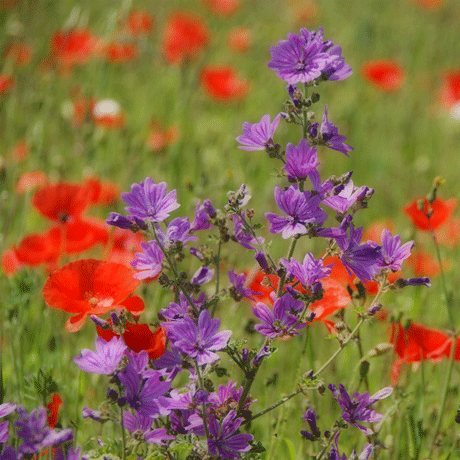 The oldest established award, that continues to be issued in current times, is the US Purple Heart. Starting out as The Badge of Military Merit (7 August 1782), which took the form of a heart made of purple cloth, the Purple Heart is the oldest military award still given to U.S. military members. Continue reading about the Purple Heart.
The oldest established award, that continues to be issued in current times, is the US Purple Heart. Starting out as The Badge of Military Merit (7 August 1782), which took the form of a heart made of purple cloth, the Purple Heart is the oldest military award still given to U.S. military members. Continue reading about the Purple Heart.
Duckboards
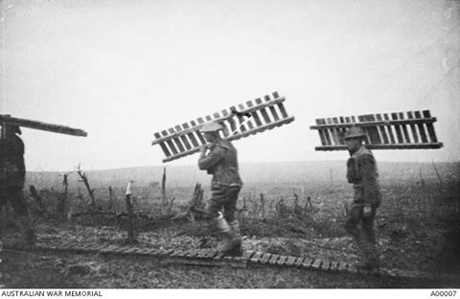 Water and mud was a huge problem in the trenches during World War I with it lying in Western Front trenches for months on end. This did not stop the Australians who had to fight on and lived in grim conditions. Wooden 'duckboards' were used to line the bottom and side walls of trenches to keep the structures standing, and assist solider to keep their feet dry to avoid trench foot. A duckboard is a platform made of wooden slats built over muddy ground to form a dry passageway. Falling or slipping off the duckboards could often be deadly, with unfortunate soldiers drowning in mud under the weight of their equipment.
Water and mud was a huge problem in the trenches during World War I with it lying in Western Front trenches for months on end. This did not stop the Australians who had to fight on and lived in grim conditions. Wooden 'duckboards' were used to line the bottom and side walls of trenches to keep the structures standing, and assist solider to keep their feet dry to avoid trench foot. A duckboard is a platform made of wooden slats built over muddy ground to form a dry passageway. Falling or slipping off the duckboards could often be deadly, with unfortunate soldiers drowning in mud under the weight of their equipment.
Brighton Army Camp
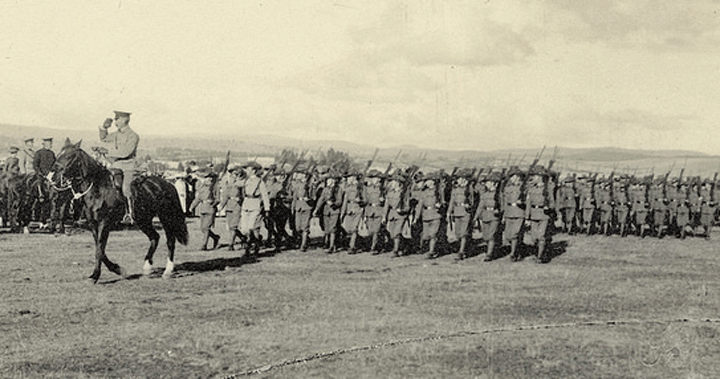 A military post was established at Brighton in Tasmania in 1826 beginning a military presence there that would last for over 170 years. Troops were prepared at the Brighton Army Camp for service in both the First and Second World Wars. During the Second World War, the camp was also used to house prisoners of war. Often the camp would be open to visitors who would share a meal with the troops.
A military post was established at Brighton in Tasmania in 1826 beginning a military presence there that would last for over 170 years. Troops were prepared at the Brighton Army Camp for service in both the First and Second World Wars. During the Second World War, the camp was also used to house prisoners of war. Often the camp would be open to visitors who would share a meal with the troops.
Unusual mascot
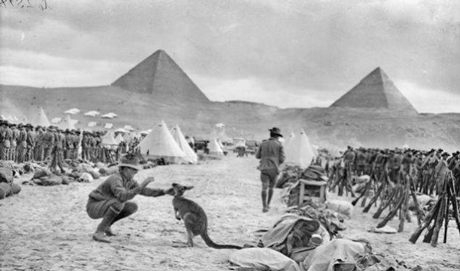 Australia took kangaroos as mascots to World War I. The photo here looks fake at first glance, like, why on Earth is there a kangaroo in Egypt?.....But in fact, Australian troops brought a number of different types of animals from home to the World War I battlefields. Call them mascots or just pals, these critters helped boost morale and helped Australia show off some of its natural heritage.
Australia took kangaroos as mascots to World War I. The photo here looks fake at first glance, like, why on Earth is there a kangaroo in Egypt?.....But in fact, Australian troops brought a number of different types of animals from home to the World War I battlefields. Call them mascots or just pals, these critters helped boost morale and helped Australia show off some of its natural heritage.
Youngest Australian to enlist
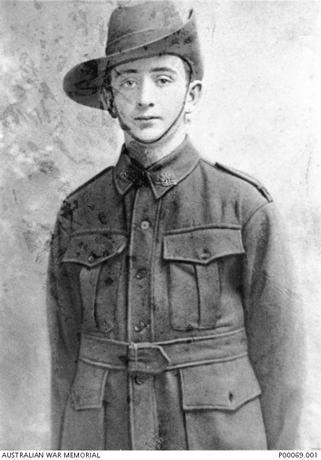 The youngest Australian to enlist in World War I was 14 year old Private James Charles (Jim) Martin. He had convinced recruiting that he was 18 years of age, when in fact, at enlistment he was 14 years and three months.
The youngest Australian to enlist in World War I was 14 year old Private James Charles (Jim) Martin. He had convinced recruiting that he was 18 years of age, when in fact, at enlistment he was 14 years and three months.
Jim landed at Gallipoli on 8 September 1915 as part of the 21st Battalion. On 25 October 1915, Jim was evacuated to the hospital ship the ‘Glenart Castle’ due to the effects of typhoid fever. He passed away from heart failure that same evening and was buried at sea.
The trenches were given names
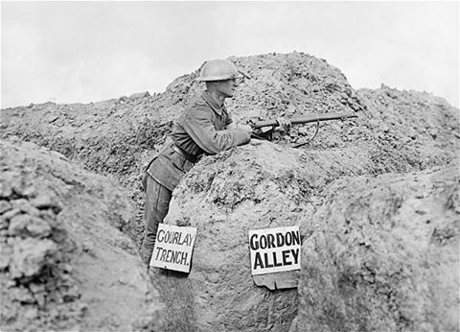 Trenches during World War I came into being as a way for soldiers to protect themselves against the firepower of the enemy. Over time, they developed into huge networks and started to all look the same. To overcome getting lost and potentially killed, trenches were given names to help identify them. Some of the names included:
Trenches during World War I came into being as a way for soldiers to protect themselves against the firepower of the enemy. Over time, they developed into huge networks and started to all look the same. To overcome getting lost and potentially killed, trenches were given names to help identify them. Some of the names included:
To Front Line;
Suicide Corner;
Petticoat Lane;
Death Valley; and
Tattenham Corner.
Bugle call
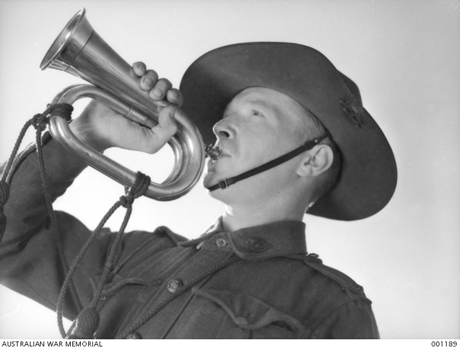 A bugle call is a short tune, originating as a military signal announcing scheduled and certain non-scheduled events on a military installation, battlefield, or ship. Historically, bugles, drums, and other loud musical instruments were used for clear communication in the noise and confusion of a battlefield. Naval bugle calls were also used to command the crew of many warships (signalling between ships being by flag hoist, semaphore, signal lamp or other means).
A bugle call is a short tune, originating as a military signal announcing scheduled and certain non-scheduled events on a military installation, battlefield, or ship. Historically, bugles, drums, and other loud musical instruments were used for clear communication in the noise and confusion of a battlefield. Naval bugle calls were also used to command the crew of many warships (signalling between ships being by flag hoist, semaphore, signal lamp or other means).
Tasmania: a dumping ground for captured circular mines.
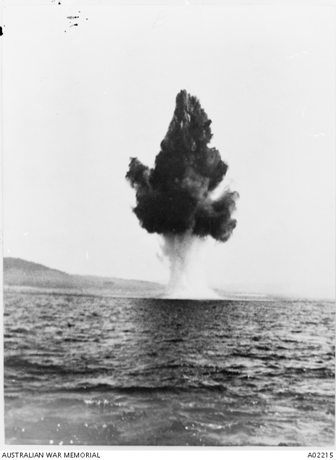 The destruction of enemy circular mines captured during war times took place off the shore of Falmouth on the East Coast of Tasmania.
The destruction of enemy circular mines captured during war times took place off the shore of Falmouth on the East Coast of Tasmania.
Mines began to appear on a large scale in 1918, as an answer to another new piece of weaponry; the assault tanks. To combat the growing number and effectiveness of American tanks, the Germans needed to design new weapons. Initially they used artillery shells dug into the ground and covered with wooden boards, to give it a wide pressure plate. But these improvised mines proved to be unreliable and time consuming to lay. In early 1918 they produced a mine that could effectively be used against tanks.
Characteristics of the Victoria Cross
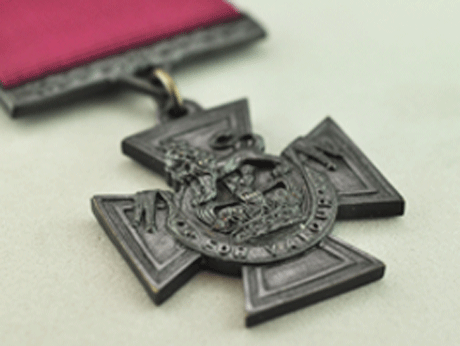 The Victoria Cross medal is cast in bronze and suspended from a crimson ribbon. It is in the shape of a Maltese Cross, bearing a crown surmounted by a lion, with the inscription ‘FOR VALOUR’.
The Victoria Cross medal is cast in bronze and suspended from a crimson ribbon. It is in the shape of a Maltese Cross, bearing a crown surmounted by a lion, with the inscription ‘FOR VALOUR’.
The Victoria Cross is the highest award for acts of bravery in the face of the enemy. It was instituted by Queen Victoria in 1856.
Camouflage trees
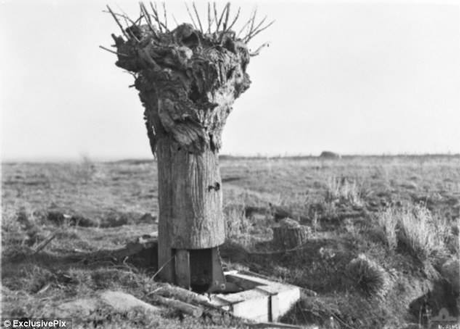 Camouflage trees concealed an observation post from which troops could watch enemy movements without being seen. The trees were replicas of battle-damaged trees in no-man's land. They were made behind the lines using sketches drawn by a camouflage artist on the battlefield. A team would then cut down the real tree at night and replace it with the replica.
Camouflage trees concealed an observation post from which troops could watch enemy movements without being seen. The trees were replicas of battle-damaged trees in no-man's land. They were made behind the lines using sketches drawn by a camouflage artist on the battlefield. A team would then cut down the real tree at night and replace it with the replica.
Paper-mâché dummy heads
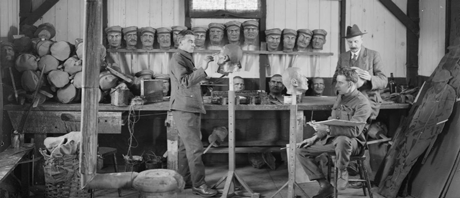 Camouflage units during the First World War made papier-mâché dummy heads in workshops to draw out enemy snipers. Any sniper firing at one of them would reveal his position.
Camouflage units during the First World War made papier-mâché dummy heads in workshops to draw out enemy snipers. Any sniper firing at one of them would reveal his position.
The acronym ANZAC
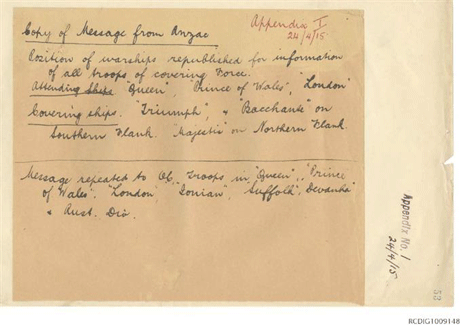 ANZAC is the acronym formed from the initial letters of the Australian and New Zealand Army Corps. This was the banner in which Australian and New Zealand soldiers in Egypt were grouped before the landing at Gallipoli in April 1915. The acronym was first written as “A & NZ Army Corps”. However, clerks in the corps headquarters soon shortened it to ANZAC as a convenient telegraphic code name for addressing telegram messages. One of the earliest appearances of “Anzac” as a word was an appendix to the 1st Australian Division War Diary, dated 24 April 1915. Read more about the term ‘ANZAC’ on the Australian War Memorial website.
ANZAC is the acronym formed from the initial letters of the Australian and New Zealand Army Corps. This was the banner in which Australian and New Zealand soldiers in Egypt were grouped before the landing at Gallipoli in April 1915. The acronym was first written as “A & NZ Army Corps”. However, clerks in the corps headquarters soon shortened it to ANZAC as a convenient telegraphic code name for addressing telegram messages. One of the earliest appearances of “Anzac” as a word was an appendix to the 1st Australian Division War Diary, dated 24 April 1915. Read more about the term ‘ANZAC’ on the Australian War Memorial website.
ANZAC biscuits
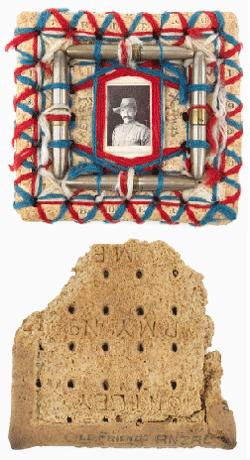 The original ANZAC biscuit, the ANZAC 'tile', was part of army rations given to ANZAC soldiers during the First World War. Unlike the popular ANZAC biscuits of today, ANZAC 'tiles' were hard tack, a simple cracker made mainly from flour and water as a substitute for bread that does not go mouldy. Soldiers also used the biscuits as paint canvases and even as photo frames. One such biscuit features the use of wool and bullets to create a picture frame.
The original ANZAC biscuit, the ANZAC 'tile', was part of army rations given to ANZAC soldiers during the First World War. Unlike the popular ANZAC biscuits of today, ANZAC 'tiles' were hard tack, a simple cracker made mainly from flour and water as a substitute for bread that does not go mouldy. Soldiers also used the biscuits as paint canvases and even as photo frames. One such biscuit features the use of wool and bullets to create a picture frame.
Purple poppy
 Most people are unaware that as well as the traditional commemorative red poppy that there are also white – symbolising peace and purple – remembering animals that died during conflicts. The purple poppy started in 2007 by Animal Aid in Britain and people are encouraged to wear the purple poppy alongside the red traditional red poppy as a reminder that both humans and animals have and continue to serve.
Most people are unaware that as well as the traditional commemorative red poppy that there are also white – symbolising peace and purple – remembering animals that died during conflicts. The purple poppy started in 2007 by Animal Aid in Britain and people are encouraged to wear the purple poppy alongside the red traditional red poppy as a reminder that both humans and animals have and continue to serve.
A second Paris
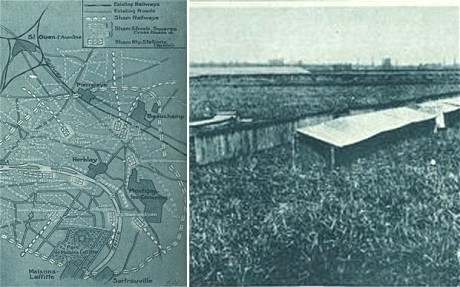 During the First World War, the French planned to create a dummy version of Paris to the city's immediate north. The idea was to fool German planes flying over the area into thinking this was the real thing. Viewed from above there were electric lights, replica buildings, a fake Gare du Nord, and a faux Champs Elysées. Fake trains and railroad tracks could be lit up as well. Would it have worked? The plan never reached fruition, so we’ll never know.
During the First World War, the French planned to create a dummy version of Paris to the city's immediate north. The idea was to fool German planes flying over the area into thinking this was the real thing. Viewed from above there were electric lights, replica buildings, a fake Gare du Nord, and a faux Champs Elysées. Fake trains and railroad tracks could be lit up as well. Would it have worked? The plan never reached fruition, so we’ll never know.
